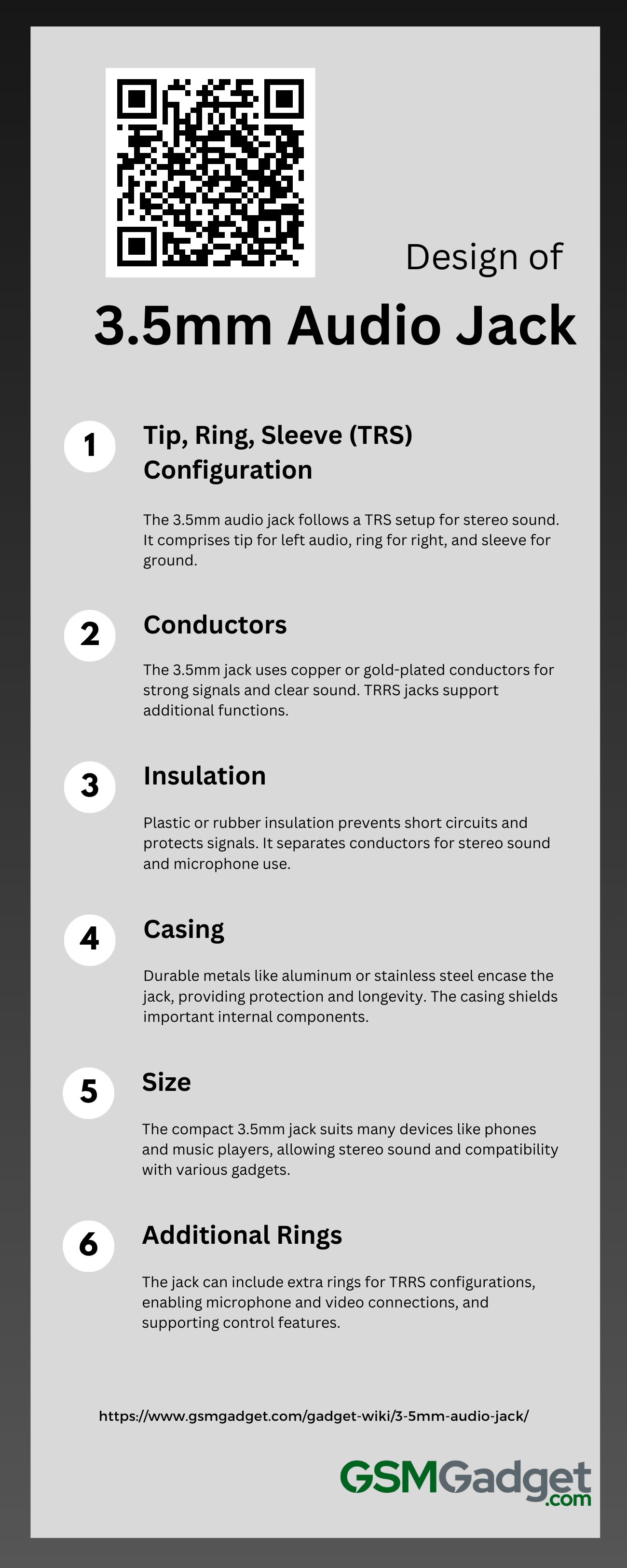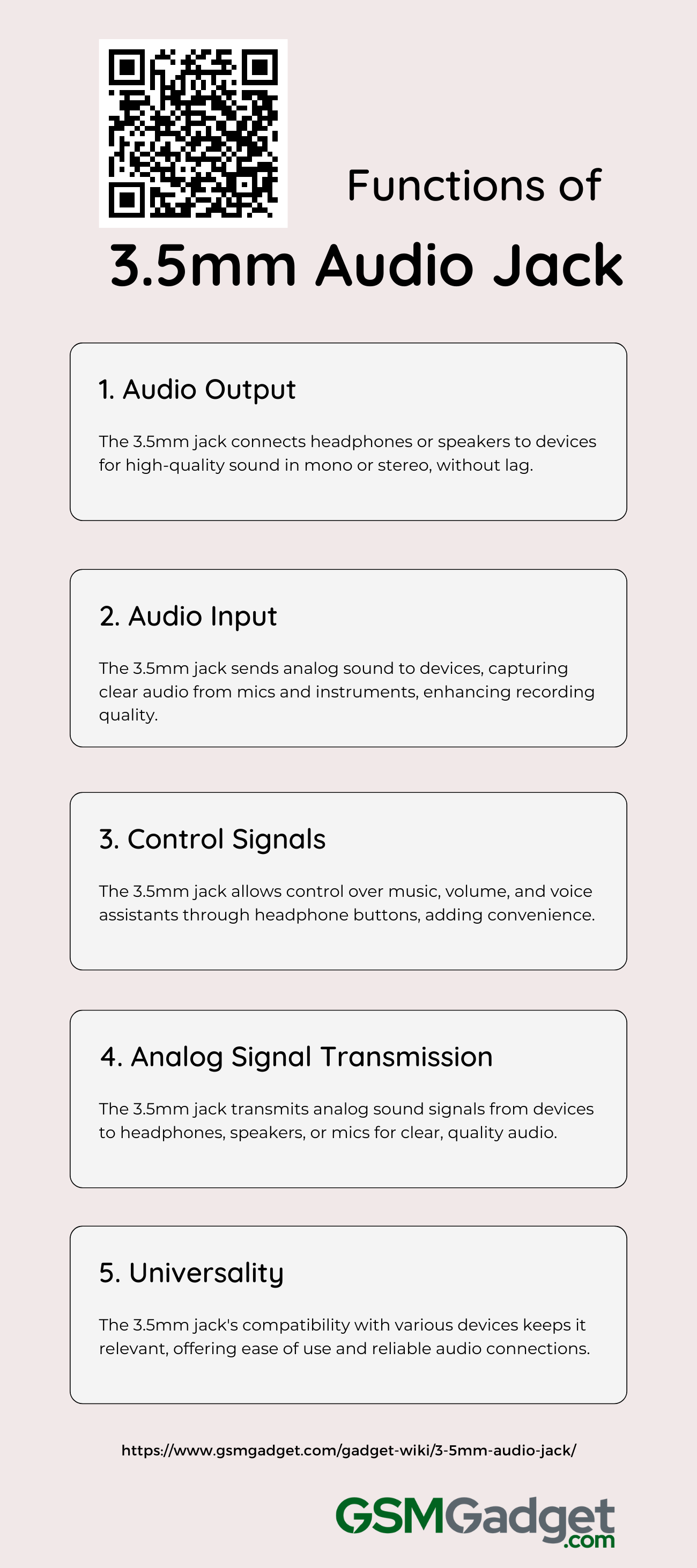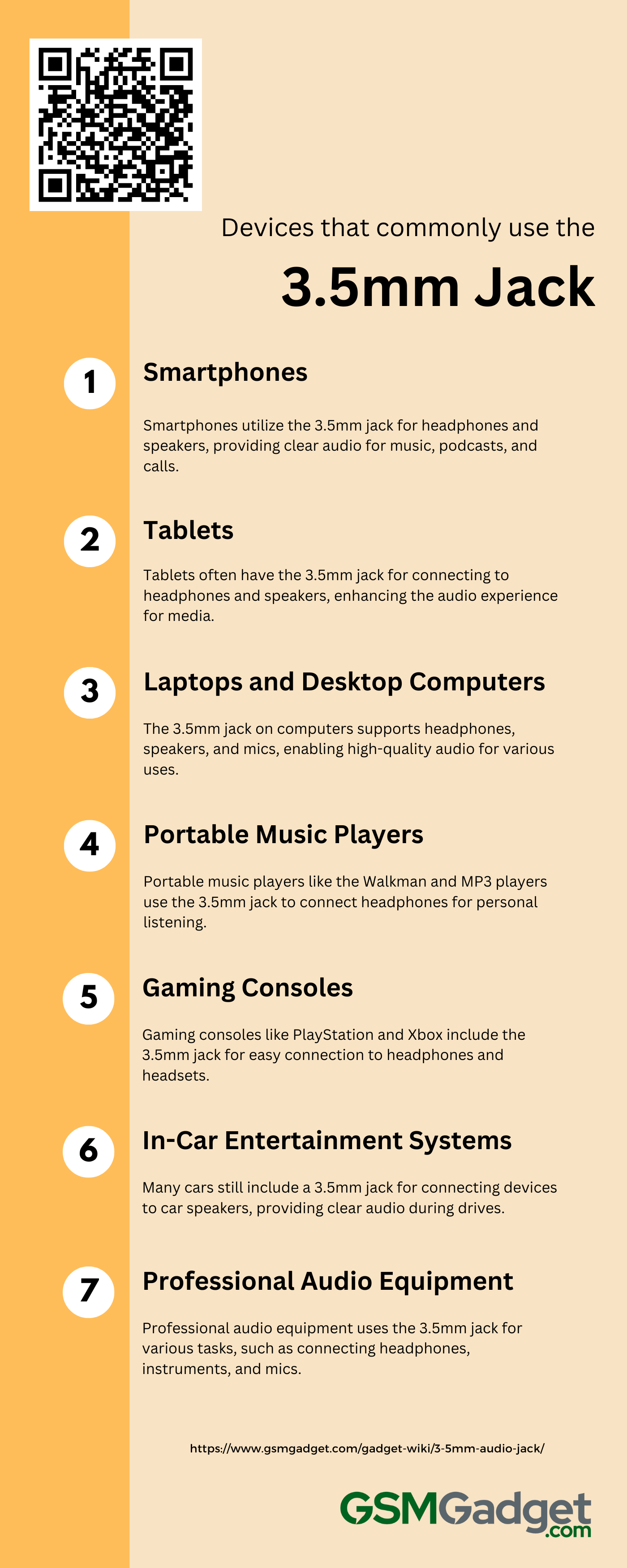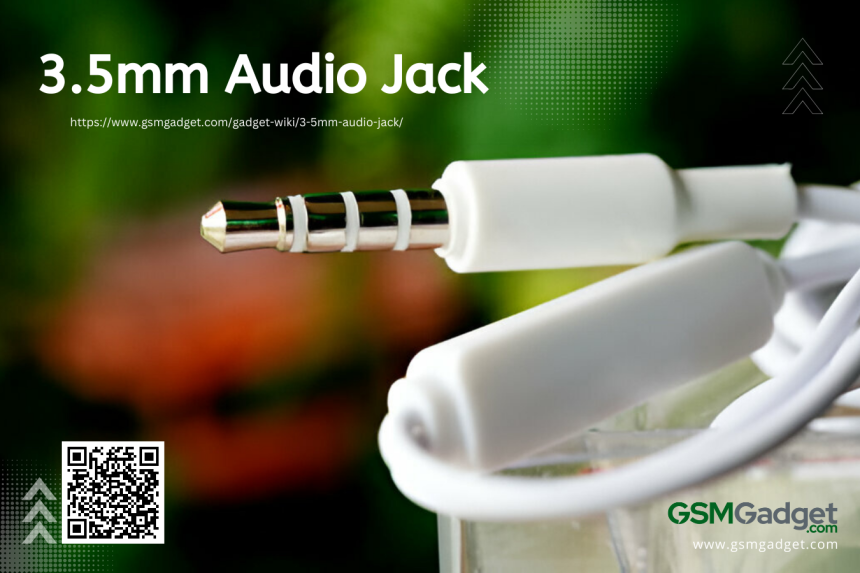The 3.5mm audio jack, also known as the headphone or auxiliary jack, is a common analog connector found in many electronic devices like smartphones, tablets, laptops, and audio gear. This small, round port has an insulating cover and contacts that connect to circuit boards. When you plug in headphones, mics, or speakers, it sends audio signals through them. Its standard shape makes it easy to use and keeps it popular even with new wireless tech. People still like the jack because it’s simple, reliable, and gives great sound without needing to change to digital. Some types even have extra features like lights or dustproof covers, plus a seal to keep the contacts inside safe and in place.
Technical specification of 3.5mm Audio Jack
| Specification | Detail |
| Connector Type | 3.5mm Audio Jack (TRS/TRRS) |
| Also Known As | Headphone Jack, Aux Jack, TRS (Tip, Ring, Sleeve) Connector |
| Diameter | 3.5mm (approximately 1/8 inch) |
| Configuration | – TRS (Tip, Ring, Sleeve) for stereo audio |
| – TRRS (Tip, Ring, Ring, Sleeve) for audio plus microphone | |
| Standard | CTIA or OMTP (depending on the configuration) |
| Material | – Contacts: Gold-plated, silver plated or nickel-plated |
| – Housing: Plastic or metal | |
| Compatibility | – Smartphones with a 3.5mm port |
| – Headphones, ear buds, headsets | |
| – Auxiliary cables for car or speaker connection | |
| Signal Type | Analog |
| Typical Use Cases | – Audio output for music and calls |
| – Audio input for headset microphones | |
| Control Functionality | – Play, pause, skip, volume control (with compatible devices and TRRS configuration) |
| Advantages | – Universal standard across devices |
| – No need for digital-to-analog conversion | |
| – Direct, low-latency audio transmission | |
| Physical Characteristics | – Typically found on the top or bottom edge of smartphones |
| – Durable and capable of multiple insertions | |
| User Considerations | – Some newer smartphones may not include a 3.5mm jack, requiring an adapter |
| – Can wear out over time with heavy use | |
| Number of Conductors | Typically 3 (TRS) or 4 (TRRS) |
| Audio Channels | Mono (2 conductors) or Stereo (3+ conductors) |
| Microphone Support | Available with TRRS configuration |
| Control Buttons | Possible integration for play, pause, volume, or call control with compatible devices Durability |
| Mating Cycles | Typically 5,000 to 10,000 insertions |
| Contact Resistance | Varies with material but typically low to maintain signal quality |
| Smartphone Cases | Jack design should accommodate most cases; deep recesses may require a slimmer plug design or an extension |
| Signal Interference | Shielded to minimize electromagnetic interference |
| Straight Plug | Common design, extends straight out from the port |
| Angled Plug | Designed to minimize stress on the cable and port |
| Uses | · For listening to audio
· To connect to speakers or car audio systems · For audio input/recording |
Design of 3.5mm Audio Jack
An iconic piece of audio tech is crafted for the best sound. Its small size and ability to work with all kinds of devices have kept it popular for many years. Let’s look closer at how it’s made and see why it’s still a top pick for connecting audio gear.

1. Tip, Ring, Sleeve (TRS) Configuration
The 3.5mm audio jack, known for its use in headphones and sound connections, has a simple yet effective design called Tip, Ring, Sleeve (TRS). It’s been around for a long time because it works so well. This small jack, or mini jack, has parts like a housing, moving pieces, switch terminals, and a plug connector that starts the action. It has three parts that carry the signal: the tip for the left audio, the ring for the right audio, and the sleeve as a common ground. This setup lets us hear stereo sound, which is way better than the old mono sound. Plus, the TRS design helps to send clear audio with less noise. The 3.5mm jack is not just good at what it does; it’s also flexible. It works with microphones, control signals, and all sorts of audio gear, like musical instruments and professional stuff. That’s why it’s a key part of how we connect audio devices.
2. Conductors
The 3.5mm jack combines easy use with complex features to give you top-notch sound. It usually has a TRS setup, which means there’s a tip for the left audio, a ring for the right, and a sleeve that’s the shared ground. Some have an extra ring (TRRS) for a mic or volume control, making them even more useful. The conductors are often copper or gold-plated copper, important for keeping the signal strong and the sound clear. This makes the 3.5mm jack a key part of audio gear.
3. Insulation
Insulation keeps out moisture and dust, making sure signals stay clear and users are safe. It’s usually made from non-conductive stuff like plastic or rubber. This stops any accidental electrical contact between the plug’s parts and your device. It keeps the audio signal pure, preventing short circuits and damage to your device. The insulation fits snugly inside the jack’s metal case. It keeps the rings that carry sound and ground apart so they don’t touch. This setup lets you get stereo sound and use a mic. It’s strong enough for lots of plugging in and out. The insulation material, often PVC or TPE, also holds everything in place. It makes sure the sound is just right and cuts down on noise mixing between channels.
4. Casing
The casing of a connector is key to its strength and how well it carries a signal. It’s made from tough metals like aluminum, stainless steel, brass, or copper alloys. These materials help it last through lots of use. The casing’s round shape fits with many devices, and it might have textures or ridges to make it easier to handle. Inside the casing, there are materials that keep it from short-circuiting and protect the sound signal. The casing holds important parts like the sleeve, ring, and tip contacts that send the signal. It’s carefully made so these parts match up with the jack plug for clear sound. The design also has features to stop rust, relieve strain, and make it easy to plug in. These all help make the audio jack reliable and easy to use.
5. Size
The 3.5mm audio jack, also known as the miniature or 1/8 inch connector, is key in electronics like phones and music players. It’s small, tough, and works with lots of devices—headphones, mics, and more. This jack is made to be tiny enough for handheld gadgets but still give a solid sound link. It uses a TRS (tip, ring, sleeve) or TRRS (tip, ring, ring, sleeve) setup for stereo sound and sometimes a mic. The design helps send clear audio without messing up how the device looks. Even though it’s small, the 3.5mm jack has helped make gadgets smaller and easier to carry around, which people really like.
6. Additional Rings
The 3.5mm audio jack is a key part in many audio devices. It has extra rings that let it do more things. At first, it was made for simple stereo sound with two rings. Now, we have the TRRS setup which means Tip, Ring, Ring, Sleeve. This new design adds a microphone, video output, and lets you talk hands-free. These improvements help connect to all kinds of media and control features like volume and playback right from the cable. Jacks with even more rings give balanced sound and work with special gear. This makes the 3.5mm jack a super flexible and lasting connector in tech.
Functions of 3.5mm Audio Jack
The 3.5mm audio jack is a common part of many gadgets. It does more than just play sound. This handy plug has several key roles that make using your devices better. Here’s what the 3.5mm audio jack can do:

1. Audio Output
The 3.5mm jack is a key part of many devices like phones, laptops, and music players. It lets you connect headphones or speakers to listen to sound in mono or stereo. This small port is easy to use and works with lots of audio gear, giving you a reliable way to enjoy music and more. Even though wireless options are popular, lots of people still like the 3.5mm jack because it doesn’t lag and doesn’t need batteries. It always gives clear, high-quality sound. Plus, when you use this jack, the device’s own digital-to-analog converter (DAC) turns digital sound into analog. This means you can hear all kinds of audio clearly.
2. Audio Input
The 3.5mm audio jack is a small, handy plug that’s key for sending analog sound to devices to be processed or recorded. It works with many input tools like mics and musical instruments. This makes it easy to use and a go-to choice for top-notch audio capture without much setup. It’s also used for external mics, helping with voice calls and recordings. Even with new digital and wireless options, the 3.5mm jack’s dependability and clear sound keep it important in tech. Content creators, musicians, and everyday users find it super useful.
3. Control Signals
The 3.5mm audio jack is more than just for sound in phones and other devices. It lets you control music, change the volume, and talk to your voice assistant with buttons on your headphones. The jack has special parts, or “rings,” that let it do this while also playing audio. This means you can make calls without using your hands. Some phones can even tell when headphones are plugged in and will stop or start your music for you. These extra features help keep the 3.5mm audio jack popular for listening to music and more.
4. Analog Signal Transmission
The 3.5mm audio jack is a key part of audio gear. It sends sound signals from devices like phones or MP3 players to things like headphones, speakers, or mics. This small plug turns electric signals into sounds we can hear, splitting them into left and right for stereo listening. If it’s a TRRS connector, it can also take in mic sounds. This means you can both listen and talk through one spot. The 3.5mm jack’s simple way of sending analog signals has kept it popular for a long time because it gives us clear, high-quality sound.
5. Universality
The 3.5mm audio jack is a true classic in the world of audio connections. It’s stayed popular even as tech changes. This little jack works with lots of devices—like phones, laptops, cameras, and music players. People love it because it’s easy to use, reliable, and doesn’t need extra stuff to work. You can listen to tunes or record sounds with it. Even though there are new wireless options out there, the 3.5mm jack is still super important. It just fits with everything and makes life easier.
Devices that commonly use the 3.5mm jack
The 3.5mm jack, often called the audio or headphone jack, is a common audio connector in many gadgets. It lets you plug in headphones, speakers, and other sound gear to your devices to listen and record sounds. Here’s a list of devices that use the 3.5mm jack:

1. Smartphones
For a long time, smartphones have used the 3.5mm audio jack. It’s been great for plugging in all kinds of things like headphones, earbuds, and car speakers. This simple plug lets you listen to music, podcasts, or audiobooks without trouble. Even though there’s a move towards wireless tech, lots of people still love the 3.5mm jack. It works with tons of devices, gives good sound, and doesn’t need charging or pairing.
2. Tablets
Tablets are super useful in school and at home. They often have a 3.5mm jack, which is a common audio plug that works with lots of headphones and speakers. This port lets you connect to different audio devices, making it better for listening to music, video calls, or making videos. Even though wireless tech is getting popular, the 3.5mm jack is still liked because it’s simple and doesn’t have battery or pairing problems. People enjoy using it because it means they can listen to stuff without any breaks and it makes using their tablets more flexible.
3. Laptops and Desktop Computers
The 3.5mm audio jack, or headphone jack, is a key part of both laptops and desktops. It’s a handy connector for many audio devices like headphones, speakers, and mics. Sometimes it even has cool features like lights from LEDs or lasers. Even with new wireless options and USB-C around, the 3.5mm jack is still popular. It’s easy to use and works with lots of different things, which makes it great for listening to music, watching videos, joining video calls, or recording audio. It’s still common in computers because it’s practical and people like how reliable wired connections are.
4. Portable Music Players
Portable music players have been giving us top-notch analog sound for years. Think about the classic Walkman and today’s MP3 players. They’ve got this small connector that lets you plug in your headphones and listen on your own. It’s tough, too—it’s kept going even with all the new wireless stuff coming out. It works with tons of different headphones and keeps the sound quality really good, which is something everyone from serious music fans to everyday listeners loves. These gadgets are getting even better, with things like vibration for deep bass, mics that pick up sound through your body, and special ear tips that block out noise and make everything sound clearer. Even though Bluetooth is everywhere now, the 3.5mm jack is still the go-to for reliable audio. Big names like the Apple iPod, Sony Walkman, and SanDisk Sansa show just how easy it is to plug in your favorite headphones and enjoy your tunes anywhere.
5. Gaming Consoles
In the world of gaming, the 3.5mm audio jack is a key feature for great sound. You can find it on controllers for the PlayStation 4, PlayStation 5, Xbox One, and Nintendo Switch Pro Controller. This port lets you easily plug in many headphones and headsets. It gives you quick access to game sounds and voice chat without needing wireless gear or adapters. The jack works with lots of audio devices, so gamers can use their favorite headphones on different systems. Even with new wireless tech, gamers still love the 3.5mm jack for its simple use and reliable connection. It makes the gaming experience better by letting players choose how they want to hear their games.
6. In-Car Entertainment Systems
Many cars still have a 3.5mm jack, proving it’s a go-to audio connector. You can find this handy input on the dashboard or center console. It lets you hook up your phone, music player, and more to play your favorite tunes, podcasts, or audiobooks through the car’s speakers. Even with new tech like Bluetooth and USB, the 3.5mm jack is a hit because it works with lots of devices and gives you clear, uncompressed sound. You’ll see it in both built-in and add-on car stereos as an aux input. It makes driving better by giving you more to listen to than just radio and CDs.
7. Professional Audio Equipment
The 3.5mm jack is a staple in pro audio gear, loved for its small size and dependability with different devices. It has many uses, like being an aux input on mixers or for headphone checks on audio interfaces. It’s handy for hooking up instruments or mics too. Pro headphones, which are key for sound engineers to hear everything clearly, use this jack. It’s also found on field recorders and portable digital recorders, making it easy to connect while you’re out and about. Some studio monitors have 3.5mm inputs, so you can plug in portable devices without a fuss. Even with new digital and wireless options, the 3.5mm jack remains popular for its ease of use and wide compatibility in the audio world.
